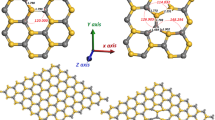Abstract
Density functional theory (DFT) calculations were performed to investigate the electronic and structural properties of pristine and Ga-doped (6,0) zigzag silicon carbide nanotubes (SiCNTs) as a p-semiconductor at the B3LYP/6-31G* level of theory in order to evaluate the influence of Ga doping on (6,0) zigzag SiCNTs. We extended the DFT calculation to predict the electronic structure properties of Ga-doped silicon carbide nanotubes, which are very important for production of solid-state devices and other applications. To this aim, pristine and Ga-doped SiCNT structures in two models (GaSi and GaC) were optimized and structural properties, the isotropic (CSI) and anisotropic (CSA) chemical shielding parameters for the sites of various 29Si and 13C atoms, and quantum molecular descriptors were calculated in the optimized structures. The optimized structures, NMR parameters, and the electronic energies for the GaSi and GaC of the (6,0) zigzag SiCNT models show that the GaSi model is a better p-semiconductor from GaC model in production of solid-state devices.
Graphical Abstract





Similar content being viewed by others
References
R. F. Davis, J. W. Palmour, and J. A. Edmond (1992). Diamond Relat. Mater. 1, 109.
N. E. Korsunska, I. Tarasov, V. Kushnirenko, and S. Ostapenko (2004). Semicon. Sci. Technol. 19, 833.
X.-H. Sun, C.-P. Li, W.-K. Wong, N.-B. Wong, C.-S. Lee, S.-T. Lee, and B.-T. Teo (2002). J. Am. Chem. Soc. 124, 14464.
M. Zhao, Y. Xia, R. Q. Zhang, and S. T. Lee (2005). J. Chem. Phys. 122, 21470.
Y. Miyamoto and B. D. Yu (2002). Appl. Phys. Lett. 80, 586.
K. M. Alam and A. K. Ray (2009). J. Nano Part. Res. 11, 1405.
A. Wu, Q. Song, L. Yang, and Q. Hao (2011). Comput. Theor. Chem. doi:10.1016/j.comptc.2011.09.013.
K. M. Alam and A. K. Ray (2007). Nanotechnology 18, 495706.
I. J. Wu and G. Y. Guo (2007). Phys. Rev. B 76, 035343.
S. Choudhary and S. Qureshi (2011). Phys. Lett. A 375, 3382.
Y. T. Yang, R. X. Ding, and J. X. Song (2011). Phys. B 406, 216.
A. Gali (2006). Phys. Rev. B 73, 245415.
F. A. Bovey Nuclear Magnetic Resonance Spectroscopy (Academic Press, San Diego, 1988).
M. T. Baei, S. Z. Sayyed Alang, A. V. Moradi, and P. Torabi (2012). J. Mol. Model. 18, 881.
M. T. Baei, A. V. Moradi, P. Torabi, and M. Moghimi (2011). Monatsh. Chem. 142, 783.
M. T. Baei, A. V. Moradi, M. Moghimi, and P. Torabi (2011). Comput. Theor. Chem. 967, 179.
M. T. Baei, A. V. Moradi, P. Torabi, and M. Moghimi (2011). Monatsh. Chem. 142, 1097.
P. K. Chattaraj, U. Sarkar, and D. R. Roy (2006). Chem. Rev. 106, 2065.
K. K. Hazarika, N. C. Baruah, and R. C. Deka (2009). Struct. Chem. 20, 1079.
R. G. Parr, L. Szentpaly, and S. Liu (1999). J. Am. Chem. Soc. 121, 1922.
M. J. Frisch, G. W. Trucks, H. B. Schlegel, G. E. Scuseria, M. A. Robb, J. R. Cheese-man, V. G. Zakrzewski, J. A. Montgomery Jr., R. E. Stratmann, J. C. Burant, S. Dapprich, J. M. Millam, A. D. Daniels, K. N. Kudin, M. C. Strain, O. Farkas, J. Tomasi, V. Barone, M. Cossi, R. Cammi, B. Mennucci, C. Pomelli, C. Adamo, S. Clifford, J. Ochterski, G. A. Petersson, P. Y. Ayala, Q. Cui, K. Morokuma, D. K. Malick, A. D. Rabuck, K. Raghavachari, J. B. Foresman, J. Cioslowski, J. V. Ortiz, A. G. Baboul, B. B. Stefanov, G. Liu, A. Liashenko, P. Piskorz, I. Komaromi, R. Gomperts, R. L. Martin, D. J. Fox, T. Keith, M. A. Al-Laham, C. Y. Peng, A. Nanayakkara, C. Gonzalez, M. Challacombe, P. M. W. Gill, B. Johnson, W. Chen, M. W. Wong, J. L. Andres, C. Gonzalez, M. Head-Gordon, E. S. Replogle, and J. A. Pople Gaussian 03, Revision B03 (Gaussian Inc., Pittsburgh, 2003).
Author information
Authors and Affiliations
Corresponding author
Rights and permissions
About this article
Cite this article
Baei, M.T., Peyghan, A.A., Moghimi, M. et al. Effect of Gallium Doping on Electronic and Structural Properties (6,0) Zigzag Silicon Carbide Nanotube as a p-Semiconductor. J Clust Sci 23, 1119–1132 (2012). https://doi.org/10.1007/s10876-012-0507-6
Received:
Published:
Issue Date:
DOI: https://doi.org/10.1007/s10876-012-0507-6




